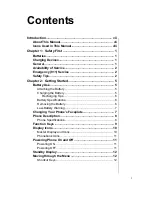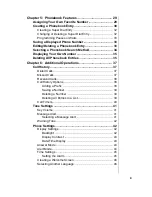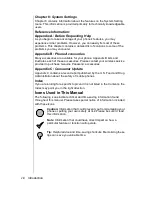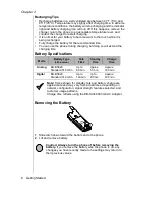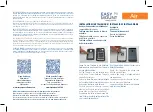
Chapter 1
4 Safety First
Persons with pacemakers:
•
Should ALWAYS keep the phone more than six inches from their pacemaker when
the phone is turned ON;
•
Should not carry the phone in a breast pocket;
•
Should use the ear opposite the pacemaker to minimize the potential for
interference;
•
If you have any reason to suspect that interference is taking place, turn your phone
OFF immediately.
•
Hearing Aids: Some digital wireless phones may interfere with some
hearing aids. In the event of such interference, you may want to consult
your service provider.
•
Other Medical Devices: If you use any other personal medical device,
consult the manufacturer of your device to determine if it is adequately
shielded from external RF energy. Your physician may be able to assist you
in obtaining this information.
Turn your phone OFF in health care facilities when any regulations posted
in these areas instruct you to do so. Hospitals or health care facilities may
be using equipment that could be sensitive to external RF energy.
•
Vehicles: RF signals may affect improperly installed or inadequately
shielded electronic systems in motor vehicles. Check with the manufacturer
or its representative regarding your vehicle. You should also consult the
manufacturer of any equipment that has been added to your vehicle.
•
Posted Facilities: Turn your phone OFF in any facility where posted
notices so require.
Aircraft
FCC regulations prohibit using your phone while in the air; switch off your
phone before boarding an aircraft unless otherwise advised by airline
personnel.
Blasting Areas
To avoid interfering with blasting operations, turn your phone OFF when in a
“blasting area” or in other areas posted: “Turn off two-way radio.” Obey all signs
and instructions.
Potentially Explosive Atmospheres
Turn your phone OFF when in any area with a potentially explosive atmosphere
and obey all signs and instructions. Sparks in such areas could cause an
explosion or fire resulting in bodily injury or even death.
Areas with a potentially explosive atmosphere are often, but not always, clearly
marked. They include fueling areas such as gas stations; below deck on boats;
fuel or chemical transfer or storage facilities; vehicles using liquefied petroleum
gas (such as propane or butane); areas where the air contains chemicals or
particles, such as grain, dust or metal powders; and any other area where you
would normally be advised to turn off your vehicle engine.
For Vehicles Equipped with an Air Bag
An air bag inflates with great force. DO NOT place objects, including both
installed or portable wireless equipment, in the area over the air bag or in the air
bag deployment area. If in-vehicle wireless equipment is improperly installed
and the air bag inflates, serious injury could result.
For U.S. Customers: Vehicles using liquefied petroleum gas (such as propane or
butane) must comply with the National Fire Protection Standard (NFPA-58).
For a copy of this standard, contact the National Fire Protection Association,
One Batterymarch Park,
PO Box 9101, Quincy, MA 02269.
E-mail address: [email protected].
Web site: www.nfpa.org.
Refer to Appendix C for the FDA Consumer Update on Mobile Phones
published by the U.S. Food and Drug Administration.
Содержание EBTX320 - Cell Phone ATLAS
Страница 2: ......
Страница 8: ...vi ...
Страница 38: ...Chapter 4 28 Text Entry Operations ...
Страница 46: ...Chapter 5 36 Phonebook Features ...
Страница 63: ...Chapter 6 Additional Operations 53 ...
Страница 64: ...Chapter 6 54 Additional Operations ...
Страница 84: ...Appendix B 72 Phone Accessories ...
Страница 93: ......



